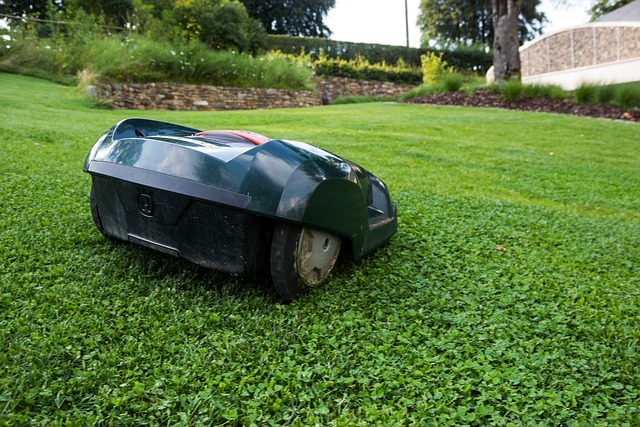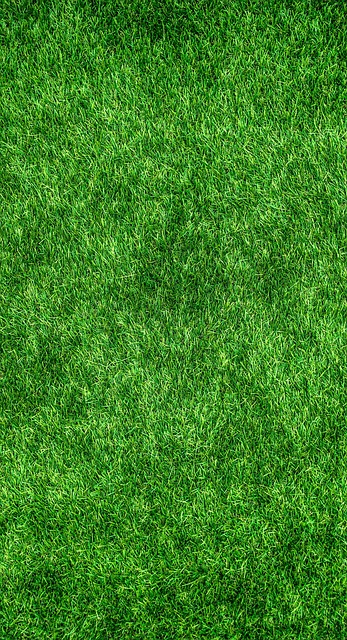Lawn Care and Landscaping are integral practices for maintaining a visually stunning and ecologically balanced outdoor space. A successful regimen involves tailoring watering schedules to grass types and local climate, mowing at the optimal height for turf resilience, and annual aeration to relieve soil compaction. Fertilization should be guided by soil tests, while weed control is essential for maintaining a healthy lawn. Over-seeding in fall addresses thin or bare patches, enhancing density and preparation for the following spring. Thoughtful landscaping design complements these practices by creating an attractive layout that aligns with personal aesthetic preferences and promotes a sustainable ecosystem. Strategic planning for garden layout considers sun exposure, wind patterns, and soil characteristics to maximize plant growth and minimize maintenance demands. Integrating elements like pathways, garden beds, water features, and landscape lighting not only adds visual appeal but also facilitates accessibility and practical care. Seasonal lawn care ensures the lawn stays healthy year-round, with specific attention to spring revival, summer hydration, fall preparation, and winter protection. By adhering to a seasonal approach and incorporating native plants, a well-maintained garden will stand out as a testament to the art of Lawn Care and Landscaping, offering sustained beauty and community distinction.
Embark on a journey through the lush greenery of garden maintenance and landscaping, where the essence of lawn care and strategic planning come together to create a visually appealing outdoor space. This article serves as a guide to nurturing your yard into a thriving haven, offering insights into efficient garden layouts that optimize both aesthetics and functionality. Discover how to enhance your property’s curb appeal through clever landscaping techniques, ensuring each season showcases the vibrancy of your garden. From essential lawn care practices to seasonal maintenance tasks, transform your outdoor space into a testament to greenery and beauty.
- Essential Lawn Care Practices for a Thriving Yard
- Strategic Planning for Efficient Garden Layout
- Enhancing Curb Appeal with Landscaping Techniques
- Seasonal Maintenance Tasks to Maintain Garden Vibrancy
Essential Lawn Care Practices for a Thriving Yard

A well-maintained lawn is a cornerstone of a beautiful landscape, contributing to both the aesthetic appeal and the health of your outdoor space. Regular lawn care practices are pivotal in fostering a thriving yard. Begin by assessing your grass type and local climate conditions to tailor your watering schedule effectively, ensuring that your lawn receives adequate hydration without excessive water waste. Consistent mowing at the right height for your grass variety prevents stress and encourages root growth. Aerating your lawn annually helps alleviate soil compaction, allowing air, water, and nutrients to penetrate the soil more easily, which is crucial for a healthy lawn. Fertilization should be done based on soil test results to provide the necessary nutrients for optimal grass growth. Weed control is also an important aspect of lawn care; it involves the selective removal or inhibition of weeds that can compete with your turfgrass for resources and sunlight. Lastly, over-seeding bare or thin patches in the fall can improve density and resilience, ensuring a lush, green yard come spring. Engaging in these essential lawn care practices will not only elevate the beauty of your landscape but also create an environment where your grass can thrive year after year. Landscaping complements these practices by enhancing the visual appeal through strategic planting, creating a harmonious and well-cultivated outdoor space that reflects your personal style while maintaining a healthy and sustainable lawn ecosystem.
Strategic Planning for Efficient Garden Layout

Engaging in strategic planning for an efficient garden layout is a cornerstone of both lawn care and landscaping. This process begins with a clear vision of the desired aesthetic, functional requirements, and the natural environment’s constraints. By mapping out the space, gardeners can optimize sun exposure, wind patterns, and soil conditions to foster a thriving ecosystem. Thoughtful placement of plants according to their light needs ensures that each species has the opportunity to flourish, reducing maintenance efforts and creating a visually appealing arrangement.
Incorporating elements such as pathways, garden beds, and water features requires careful consideration. These features not only enhance the beauty of the garden but also facilitate ease of movement and upkeep. Lawn care practices become more effective when the layout supports them, such as allowing for efficient mowing patterns or providing space for composting. By adopting a design that respects the natural contours of the land, landscaping becomes a harmonious blend of form and function, resulting in a garden that is both beautiful and easy to maintain.
Enhancing Curb Appeal with Landscaping Techniques

Engaging in regular lawn care and landscaping can significantly enhance your property’s curb appeal, creating an inviting first impression for visitors and passersby. Strategic lawn maintenance, such as consistent mowing, edging, and aerating, fosters a well-manicured look that serves as the foundation for an aesthetically pleasing outdoor space. Consider the layout of your garden; a thoughtful arrangement of plants, shrubs, and flowers can complement the architecture of your home while introducing a variety of textures, colors, and heights to captivate the eye. The use of native plants not only adds to the local ecosystem but also reflects the unique character of your region. Additionally, incorporating garden structures like benches, fountains, or pergolas can add depth and interest to your landscape design, making it both functional and visually striking. By integrating lighting to highlight key features in the evenings, you can further emphasize the beauty of your outdoor space, creating a warm ambiance that beckons guests and enhances your home’s appeal.
To truly make an impact, consider the seasonal transitions in your garden. The introduction of annuals and perennials that bloom at different times ensures year-round color and vibrancy. Regular upkeep, such as pruning, weeding, and mulching, not only maintains healthier plants but also contributes to a tidy and well-maintained appearance. By combining these lawn care and landscaping practices, you can achieve a harmonious balance between nature and design that elevates your home’s exterior, making it a standout in the neighborhood.
Seasonal Maintenance Tasks to Maintain Garden Vibrancy

Engaging in seasonal maintenance tasks is key to preserving the vibrancy of your garden. During the early spring, focus on revitalizing your lawn care routine by raking away debris, aerating the soil to allow for better nutrient uptake, and overseeing a thorough lawn feeding schedule to foster healthy turf growth. As temperatures rise and the growing season commences, regular mowing at the appropriate height for your grass type becomes essential, along with consistent watering to maintain moisture levels, especially during drier spells.
As summer transitions to fall, prepare for the changing season by gradually reducing fertilization to prevent late-season growth that could be damaged by early frosts. This is also the time to clean up fallen leaves and other organic matter to prevent disease and pest issues over winter. Autumn is also prime time for planting bulbs that will burst forth with color in the following spring, ensuring a spectacular display of blooms. Finally, as winter approaches, take measures to protect delicate plants and evergreens from harsh weather conditions, and consider mulching to insulate soil temperatures. With a diligent approach to lawn care and landscaping throughout the seasons, your garden will remain a lush and vibrant oasis all year round.






